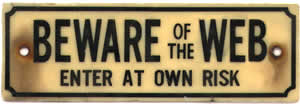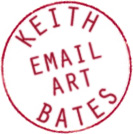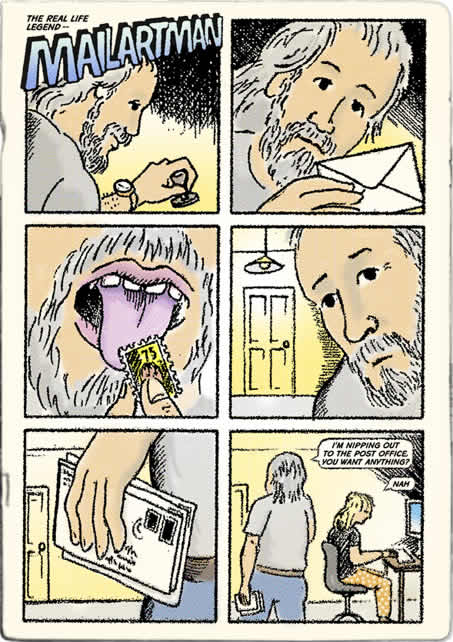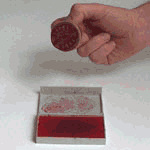Email Art – the Unprinted Page

As long as there is an international postal system, Email Art will never wholly replace the sights and sensations of the postal experience, yet email, with its own distinct qualities and limitations, has become the vehicle of choice for a new wave of networking artists, and a vehicle of convenience for the old wave. The most obvious deficiency is Email Art's lack of physical substance. Michael Lumb once expressed the opinion of many mailartists, 'there is no substitute for the actual tactile object'. The fetishistic feel and smell of paper runs deep, but new media brings its own comforts and new allegiances, and the times are most definitely a-changing.

In 2006, I had some email chats with Anna Banana about her frustration at receiving large email attachments that were causing bottleneck congestion to people with dial-up internet connections. To some extent our inexperience with sending emails were compounding the problem - hitting a reply-to-all button or sending needlessly large images. And if we had a fast broadband connection, we tended to assume everyone else had one too. When Ruud Janssen and others pioneered the use of the internet for exchange, I wasn't online and began to feel just like Anna, that I was 'lost in the Dark Ages'. But as broadband became more affordable, most of the old problems associated with slow transfer speeds and file sizes began to disappear, and concerns about viruses and spam became manageable.
Six years later, many mailartists are still passionate about traditional postal art, but due to practical considerations of cost and convenience now look more favourably on email and the internet. It has become commonplace for those who initiate Mail Art projects to publicise information by email. It has also become the norm for contributions to be displayed online instead of sending printed documentation.
Participation by email, however, has been much slower to gain acceptance, and in September 2012 I emailed the following rant to about 200 mailartists requesting that Email Art should become a generally accepted method of participating in Mail Art projects...

2012 - A Rant and a Request
Although I'm not as prolific a mailartist as I once was, abducted by fontmaking a decade ago, I'll always enjoy contributing to projects that interest me. However, I've noticed that the kind of networking I like best has changed over the years. For a start my love affair with post offices has been tainted by long queues and steep price rises. Also, my ample archive of Mail Art treasure is threatening an undignified escape from the confines of its wardrobe, while digital storage keeps getting cheaper and easier.
I find myself liking the idea of Email Art - art without the artifact. And if Ervin Zsubori's MinEmailArt is a good indicator of things to come, I'm also enjoying the practice. Ervin's projects are thoughtfully themed and timely, participation by email is quick and convenient (and fun), and contributions are displayed cleanly with graphic flair. After years of considering myself something of a paper fetishist, I'm loving the screen maybe more.
I can think of only a handful of my recent mailartworks where consigning papers to the post was important because of faux perforations or tactile qualities, and while I wouldn't wish to stop having access to snailmail, poorer service notwithstanding, most of the Mail Art contributions I send are essentially images that don't require a physical presence. Many pieces are digital to begin with, so it makes no sense to print them out and send them by post, only to be scanned upon receipt for displaying on a blog or in website documentation.
Although I've never felt comfortable with Mail Art Tourism and so received news about the 2012 Decentralized Networker Congress with little enthusiasm, I have been heartened to see that Email artists are being asked to send printable works which will be exhibited alongside postally-delivered submissions.
I'd like to see equal rights for Email Art throughout the network. It's high time that Mail Art became openly accepting of digital contributions and old prejudices renounced. As project organisers acquire high-speed internet access, genuine concerns about hefty file sizes and slow download speeds are evaporating. Software improvements have helped allay fears about computer viruses, it's pretty safe to accept all the familiar picture, audio and movie file formats. Mail Art has always been open and inclusive, and offering the email option can only result in greater participation. Most project organisers could make email attachments as welcome as postcards and give artists the freedom to choose how their work is delivered.
The Mailart Typeface project from 2004, was a project that was conducted by both conventional mail and email, allowing each participant to choose. Similarly with my Cameraderie mailartists photoportraits project a few years later, many artists preferred to send digital images. I sense my new Email Art project may be coming soon, though in deference to fifty years of history I'm keen to include the traditional option.
In the meantime, I'll continue to make art exchanges over the internet and would like to receive details of Mail Art actions that encourage online participation and welcome submissions sent as email attachments. Please send me information about any Mail Art projects you come across where Email Art contributions are allowed or preferred.
Mail Art in the Age of the Internet
I received quite a few replies from mailartists keen to offer opinions on the subject of Email Art and have been moved to explore the issues more fully in an article entitled 'Mail Art in the Age of the Internet'.



